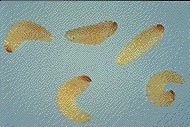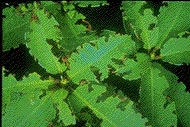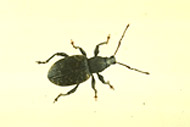YOU ARE HERE Pest Watch > Vine weevil control
Pest Watch
Vine weevil control
Vine weevil is a garden plant pest problem that can be difficult to control. Gardeners with vine weevil will need to take measures to control them.
Vine weevil is one plant insect pest that most gardeners live in fear of. And it is a pest to worry about. Suddenly, otherwise healthy-looking plants collapse and die thanks to the root-eating, soil-borne grubs.
You should suspect a vine weevil attack if watering does not revive the plant. In severe cases, plants may be completely severed from their roots at ground level.
In the past, their favourite food was fuchsias, cyclamen, begonias and primulas. But in recent years they have become less fussy and will make a meal of a much wider range of plants - especially any that are growing in containers. This is possibly due to the use of peat-based and peat-free composts - being less gritty than John Innes composts, the adults are more likely to lay their eggs in them.
What to do if you notice a vine weevil attack?
Don't despair, there are several ways of dealing with this plant-nibbling nasty. It is important to be vigilant and keep a close eye on all your plants - especially those that are known to be favourites on the menu.
Always check the rootballs for grubs before you buy plants. Check when potting up or repotting plants, and destroy any that you see; it usually pays to dispose of affected compost too.
Because vine weevil is such a destructive pest, every effort must be taken to control both the adults and the soil-borne grubs.
There are three ways of controlling vine weevil: chemical, biological control and physical barriers.
Controlling vine weevil grubs
|
Typical vine weevil grubs, which will eat the roots of a wide range of different plants. They are creamy-white, up to 13mm (0.5in) long, C-shaped, with a brown head and no legs. Often the first signs of damage are only spotted when a plant completely wilts and dies. |
Commercial nurseries may sometimes add chemicals to the compost to control them. It is always worth asking when you are buying particularly susceptible plants if any such chemicals have been used.
There are a number of insecticides that can be used to treat plants and give protection against attack.
BugClear Ultra Vine Weevil Killer is a systemic insecticide that can be used for container-grown plants (except edible ones). It is watered onto the compost.
Provanto Ultimate Bug Killer, Provanto Fruit & Vegetable Bug Killer, Resolva Bug Killer and BugClear Ultra are sprayed onto plant foliage to kill leaf pests; some edible plants can be treated, so check the label first.
Use plant protection products safely. Always read the label and product information before use.
If you don't like using pesticides, use a biological control based on nematodes. These microscopic creatures enter the bodies of the grubs and release a specific bacteria that poisons and kills them. They then multiply and go on to attack other grubs. The nematodes are available from several mail order supplies, such as Green Gardener.
Neudorff now supplies biological nematode controls to garden centres, so you no longer have to rely on mail order suppliers - and have to wait for them to be delivered.
Controlling vine weevil beetles
|
Typical vine weevil beetle damage to rhododendron leaves... |
|
..and a typical vine weevil adult beetle. |
One of the most effective - but time-consuming - methods of controlling the adult vine weevil beetles is to check your plants at night when they are active and feeding. They can then be scooped up and disposed of.
Another way is to use a physical barrier as the adult beetles cannot fly from plant to plant. Stand potted plants on upturned pots sat in saucers of water - the adults can't swim. Or surround the pots with Barrier Glue available from Agralan - the adults cannot walk across it. With either of these methods it is important to move plants away from walls or greenhouse/conservatory walls as the adults can jump down onto them; they cannot fly.
Physical barriers on top of the soil or compost also work very well. Add a 2cm (0.75in) deep layer of sharp grit or gritty gravel on top of the compost or around the base of the plant to prevent the adults from laying eggs; the egg-laying structure is irritated by the scratchy feel.
Or you can use Zee No Weevil, a granular product applied to the surface of compost or around the base of susceptible plants. It is made from dried, crushed olive pommace (the dried leftovers from making organic olive oil) and aromatic Mediterranean herbs.
And you can also control the adult beetles with nematodes, using Nematop Adult Vine Weevil Traps.
Vine weevil eggs
All vine weevil adults are female, and each one can lay hundreds to thousands of eggs from April to September; the main egg-laying periods are April and August/September.
If you spot golden-brown or clear egg-like objects in the soil or compost then they're NOT vine weevil eggs. Vine weevil eggs are brown and tiny and you'd need a hand lens to see them. Clear spheres are usually slug or snail eggs and the golden-brown ones are actually controlled-release fertiliser!
If you want to know more, or if you've got a gardening problem you need help with, then send an e-mail to: info@gardenforumhorticulture.co.uk
Problems with slugs & snails, aphids, scale insect, whitefly or lily beetle?





